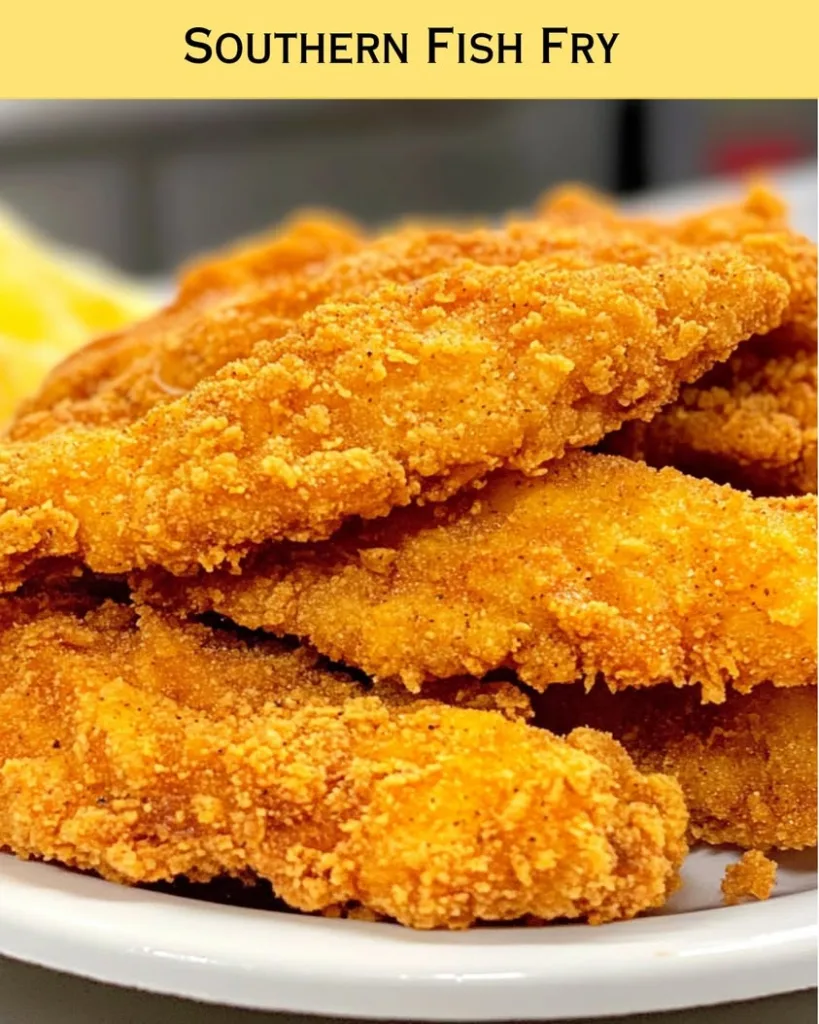Southern Fish Fry: A Crispy, Flavorful Delight
When you think of Southern cuisine, nothing quite captures the essence like a classic Southern fish fry. This delectable dish is renowned for its crispy coating and tender, flaky fish that melts in your mouth. Each bite is infused with old-fashioned Southern charm, bringing to mind summer nights spent gathered around with friends and family. The perfect combination of spices and a golden-brown crust elevates the fish to make it the star of any meal. It’s a celebration of deep-fried goodness that reflects the rich culinary traditions of the South.
Not only does this Southern fish fry satisfy your taste buds, but it also warms the heart. The aroma of seasoned fish frying in hot oil fills the air, eliciting smiles and a sense of home. Perfect for gatherings or a quiet weeknight dinner, this dish is ideal for both casual and festive occasions. Southerners take great pride in their fried fish, and for good reason: it’s a beautiful harmony of flavor and texture that is hard to resist.
Quick Recipe Highlights
- Flavor Profile: This Southern fish fry features a savory mix of spices that create a zesty flavor profile, perfectly complemented by the sweetness of the fish.
- Texture: The crispy outer crust offers a delightful crunch that contrasts beautifully with the soft, flaky fish inside.
- Aroma: The warm, inviting aroma of frying fish combined with hints of paprika and garlic creates a nostalgic experience.
- Visual Appeal: Golden-brown fillets served with a sprinkle of fresh parsley are as pleasing to the eyes as they are to the palate.
- Skill Level Needed: This medium-level recipe is perfect for home cooks looking to elevate their frying skills without being overly complicated.
- Special Equipment: You’ll need a deep fryer or a heavy-bottomed pot to achieve that perfect frying temperature.
Recipe Overview
- Difficulty Level: This Southern fish fry falls under medium difficulty due to the frying technique but is accessible for most home cooks.
- Category: This dish is perfect for main courses or party appetizers, making it a versatile addition to your recipe collection.
- Cuisine: Rooted in Southern traditions, this dish reflects the bold, flavorful cooking synonymous with the American South, influenced by African, Native American, and European culinary practices.
- Cost: Fried fish is budget-friendly, using economical white fish like catfish or tilapia, making it a great choice for family meals.
- Season: While delicious year-round, summer is the perfect time for a Southern fish fry, enjoying outdoor cooking on warmer evenings.
- Occasion: Ideal for backyard barbecues, family reunions, or holiday gatherings, this dish always brings people together.
Why You’ll Love This Recipe
The taste and texture appeal of a Southern fish fry is undeniably captivating; each bite is packed with a crunch from the well-seasoned, crispy coating that gives way to the tender fish. This contrast creates a delightful eating experience that’s both satisfying and savory.
Convenience shines with this recipe, as it utilizes straightforward ingredients and minimal prep time, allowing you to whip up a delicious meal without extensive effort. It’s perfect for both time-starved weeknights and spontaneous gatherings with friends.
Nutritionally, fish offers lean protein and essential omega-3 fatty acids, making it a health-conscious choice. Coupled with a garden salad or homemade coleslaw, this dish offers balanced nutrition that keeps you feeling satisfied.
As a crowd-pleasing dish, a Southern fish fry enhances social gatherings. It invites conversation and sharing, transforming any meal into a celebration where everyone can enjoy delicious food together.
With affordability being key, this recipe leverages cost-effective ingredients while still delivering great flavor. You can maintain quality without breaking the bank, making it an accessible choice for families, large gatherings, and casual home dinners.
Historical Background and Cultural Significance
The origins of the Southern fish fry can be traced back to African and Native American traditions that emphasized utilizing available resources in cooking. Fish has long been a staple in Southern diets, with frying becoming a favored cooking method due to its accessibility and ability to create crispy, delectable dishes.
Culturally, the Southern fish fry holds a special place in community gatherings and church picnics. It’s a classic dish that reflects the hospitality and warmth characteristic of Southern culture, bringing people together to share laughter and conversation over a satisfying meal.
Through years of culinary evolution, different regions have adapted the southern fish fry to showcase local flavors and fish varieties. From the Gulf Coast to Appalachia, each region contributes its own twist that enhances this traditional dish.
Regional variations include using distinct coatings like cornmeal or cracker crumbs, and different types of fish depending on local catches, which lend their unique tastes to the dish, maintaining its foundational appeal.
Ingredient Deep Dive
Fish
Fish such as catfish or tilapia are popular choices in Southern cooking, celebrated for their mild flavor and flaky texture. Rich in protein and low in fat, they serve as a healthy choice in many diets, particularly when fried.
When selecting fish, look for fresh fillets with a mild scent and firm flesh. Proper storage includes keeping them refrigerated in a sealed container and consuming them within a couple of days for the best quality. Fish can also be frozen for longer preservation; simply ensure it is well-wrapped to prevent freezer burn.
Breading
The breading mixture typically includes flour and cornmeal, offering a unique texture and flavor that’s characteristic of Southern frying. Cornmeal enhances the crunch and can be seasoned with various spices to elevate the taste.
For those who prefer a gluten-free option, alternatives such as almond flour or chickpea flour can be used, maintaining the desired texture and flavor while accommodating dietary restrictions.
Common Mistakes to Avoid
- Not drying the fish properly can lead to soggy breading instead of a crispy finish. Use paper towels to ensure the fillets are moisture-free before seasoning.
- Using oil that is not hot enough can result in oily fish rather than a crispy exterior. Aim for a temperature between 350°F to 375°F for optimal frying results.
- Overcrowding the frying pan can lower the oil temperature, causing the fish to steam rather than fry. Fry in smaller batches for the best outcome.
- Neglecting to season the fish before frying can lead to bland flavor. A simple seasoning blend can significantly enhance the dish’s taste.
- Skipping the rest time after frying can ruin the texture; allow the fried fish to sit for a few minutes on a wire rack to maintain crispness.
- Using old oil can result in off-flavors; ensure you use fresh oil to enhance the flavor of your fish fry.
- Not using a thermometer to check the oil temperature makes achieving the perfect frying experience more challenging. A thermometer can help maintain consistent results.
- Allowing the oil to get too hot can lead to burnt breading and undercooked fish; always monitor the oil temperature during frying.
- Ignoring the importance of draining excess oil after frying can lead to greasy fish; use a wire rack for proper drainage.
- Forgetting to separate breading ingredients can result in clumping, so make sure to have a proper setup before you begin frying.
Essential Techniques
Mastering the frying technique is crucial for achieving that golden-brown crispy crust. It’s essential to maintain the correct oil temperature, allowing the fish to cook evenly without absorbing excess oil. Use a thermometer to gauge the heat accurately.
Coating the fish properly is equally important; ensure even coverage of breading for a harmonious texture. Start with a flour coat, followed by egg wash, and finish with the seasoned cornmeal flour. This layering creates a substantial crust that holds up during frying.
Pro Tips for Perfect Southern Fish Fry
To elevate your Southern fish fry, try marinating the fish in buttermilk for at least an hour to enhance moisture and flavor. This technique also tenderizes the fish for a more enjoyable eating experience.
Experiment with spices in your breading mix such as paprika, garlic powder, or cayenne for an added flavor boost that aligns with traditional southern tastes.
When frying, consider using a mix of oils, like combining vegetable oil with a touch of bacon grease for rich flavor and better frying results.
Maintain a watchful eye on the frying process; the fish is done when it reaches a golden brown appearance and an internal temperature of 145°F.
If making larger batches, keep the fried fish warm in an oven set at low heat (around 200°F) until all batches are done to enjoy them hot.
Don’t forget to serve fresh lemon wedges alongside your fried fish; the acidity enhances flavors and cuts through the richness of the fried breading.
Variations and Adaptations
Regional variations of Southern fish fry include Louisiana-style fish fry with Cajun spices, while Coastal areas may feature beer batter for a lighter, fluffier texture.
Seasonal adaptations can involve incorporating local fish varieties or even game fish during fishing seasons to keep the dish fresh and exciting.
For dietary modifications, consider using alternative flours for coating, such as almond flour or chickpea flour, which provide a gluten-free option.
Flavor variations can include infusing your oil with herbs like rosemary or thyme before frying to create a subtle aromatic background.
Texture modifications could involve using panko breadcrumbs for an extra crunchy finish, offering a delightful variation from classic cornmeal.
Presentation alternatives might involve serving the fish on a bed of lemon slices or alongside vibrant summer salads for a refreshing contrast.
Serving and Presentation Guide
Plating the Southern fish fry can elevate the dish; consider a shallow bowl lined with fresh greens and the crispy fish stacked on top, surrounded by colorful garnishes like diced tomatoes and fresh herbs.
Garnishing ideas could include slices of lemon, fresh parsley, or even a drizzle of remoulade sauce for added flavor and visual appeal.
Traditional accompaniments can feature coleslaw or cornbread, balancing the flavors and enhancing the Southern experience.
For modern serving suggestions, consider pairing the fish with homemade tartar sauce or salsa, catering to diverse taste preferences.
Always serve the fish hot and fresh, as temperature can significantly impact flavor and enjoyment. Use warming techniques if preparing multiple batches.
Portion control tips encourage serving the fish in smaller pieces, allowing guests to sample more flavors and share during mealtimes.
Wine and Beverage Pairing
When it comes to wine pairings, a crisp, chilled Sauvignon Blanc complements the Southern fish fry, while its acidity cuts through the richness of the dish.
For non-alcoholic alternatives, a sparkling lemon soda or iced tea with lemon makes for refreshing accompaniments that complement the meal.
If you’re seeking coffee or tea pairings, consider a light, floral herbal tea that won’t overpower the flavors of the fish.
Serving suggestions include chilling beverages beforehand, ensuring they are refreshing against the warmth of the fried fish.
Storage and Shelf Life
For proper storage, allow leftover fish to cool before placing it in an airtight container in the refrigerator; it will remain fresh for up to three days.
The ideal temperature for storing leftover fried fish is below 40°F to ensure quality and safety; check your refrigerator thermometer regularly.
For reheating, place the fish in an oven preheated to 350°F for about 10-15 minutes, ensuring the coating remains crispy and the fish is heated through.
If you wish to freeze the fish, wrap each piece in plastic wrap and place them in a freezer-safe bag, where they can last up to three months.
Signs of spoilage include an off-putting smell or a change in texture; always assess visually and through smell before consuming.
Make Ahead Strategies
To streamline your cooking process, prepare the breading mixture in advance and store it in a sealed bag, ready to use when you need it.
Fish can be marinated the night before, allowing the flavors to deepen and reducing prep time on the day of the cooking.
Before frying, set up your stations to maximize efficiency, with a designated area for each step in the frying process for a smoother workflow.
Consider a reheat strategy; breaded fish can be cooked halfway, cooled, and stored until you are ready to complete the frying process, saving time during serving.
If you aim to serve with additional components like slaw or sauces, prepare those earlier in the day to ensure quick assembly.
Scaling Instructions
To halve the recipe, simply divide all ingredient amounts by two, adjusting the cook time if necessary, especially if using smaller batches.
Doubling the recipe may require using multiple frying pans or cooking in batches to manage the cooking temperature effectively while avoiding overcrowding.
When scaling, keep an eye on the timing; larger quantities can take slightly longer to cook, so adjust based on visual and temperature cues.
Equipment adjustments may include increased oil volume or larger pots to accommodate more fish, maintaining optimal frying space and oil temperature.
For storage, doubling the recipe means you’ll need to ensure there’s sufficient refrigerator or freezer space for leftovers.
Nutritional Deep Dive
The macro breakdown of your Southern fish fry reveals a lean protein source, while the breading adds carbohydrates. Balance your plate with the right accompaniments to achieve dietary goals.
A micronutrient analysis shows that fish is rich in omega-3 fatty acids and provides essential vitamins like B12, adding nutritional depth to your meal.
Highlight health benefits, noting that consuming lean fish can support heart health and cholesterol management, making it a wise dietary choice.
For those mindful of dietary considerations, keep in mind portion sizes; balance fried items with lighter sides to stay within caloric needs.
Weight management tips can also remind you that fried food can be enjoyable in moderation, encouraging balanced eating habits.
Dietary Adaptations
For gluten-free options, using gluten-free breading mixes or alternative flours ensures that everyone can enjoy this Southern classic.
Dairy-free adaptations can include using plant-based milk substitutes for breading and leave out any dairy-based marinades while keeping flavor through herbs and spices.
Vegan adaptations might center around using tofu or eggplant as your base, coated with seasonal veggies instead of fish.
Low-carb versions could replace breading with almond flour or finely crushed pork rinds, maintaining a crispy texture without excess carbohydrates.
For those following a keto or paleo diet, selecting fish as a primary protein source aligns well, and utilizing healthy fats in cooking enhances nutritional value.
Consider low-FODMAP options by steering clear of certain seasonings for those with sensitivities, ensuring an inclusive dining experience.
Troubleshooting Guide
If you encounter texture issues, focus on temperature control; undercooked fish can be reversed by quickly frying at a higher heat until perfect.
Flavor balance can be adjusted post-fry; serve with flavorful sauces or toppings to enhance enjoyment if it lacks seasoning.
Temperature problems often arise from incorrect oil heat; use a thermometer to maintain consistency and avoid soggy fish.
When facing equipment challenges, ensure that you’re using the right tools, such as a heavy-bottomed pot to prevent oil temperature fluctuations.
Ingredient substitutions are manageable; maintaining proportions and types will help achieve the same flavor or texture.
Timing concerns can be managed by having a helper in the kitchen or adjusting the number of batches you fry based on the number of servings.
Recipe Success Stories
Our community thrives on feedback, with many sharing their love for the Southern fish fry recipe. Readers frequently comment on how it brings back cherished memories of family gatherings.
Variation successes add to the beauty of this dish; people love experimenting with different fish or regional seasonings, resulting in exciting new flavor profiles.
Adaptation stories often highlight how this recipe has been a gateway for individuals to learn frying techniques that lead to confidence in the kitchen.
Reader suggestions frequently enhance the recipe, leading to various accompaniments and creative twists, which bring out the creativity in home cooking.
Photography tips shared in success stories inspire others to capture their dishes beautifully and share them with the community.
Frequently Asked Questions
What type of fish is best for frying?
Mild white fish like catfish, tilapia, or cod are popular choices for frying due to their flavor and texture. They hold up well to the breading and cooking process.
Can I use frozen fish for this recipe?
Yes, frozen fish can be used, but make sure to thaw it completely before marinating and breading. This ensures an even cook and prevents excess moisture.
How do I know when the fish is done frying?
The fish is done when it reaches a golden brown color and an internal temperature of 145°F. It should also flake easily with a fork.
Can I make this recipe ahead of time?
Yes, the fish can be breaded ahead of time and refrigerated until ready to fry. However, it is best when served fresh for optimal texture.
What oil is best for frying fish?
Vegetable oil, peanut oil, or canola oil are great choices for frying due to their high smoke points and neutral flavors that complement the fish.
Can I bake the fish instead of frying it?
While frying gives the classic texture, you can bake the fish at a high temperature with a light coating for a healthier alternative, but it won’t be as crispy.
Why is my breading falling off during frying?
Improper coating or not allowing the breading to adhere well can cause this. Make sure to evenly coat the fish in flour, egg, and then breading.
Can I substitute the breading?
Yes, you can use panko breadcrumbs or crushed crackers for a different texture. For gluten-free options, almond flour or gluten-free breadcrumbs work well.
How can I reheat leftover fried fish?
Reheat the fish in an oven set to 350°F for about 10-15 minutes, or until heated through. This helps maintain its crispy texture.
What sides pair well with Southern fish fry?
Classic sides include coleslaw, cornbread, hushpuppies, or a side salad. These complement the richness of the fish nicely.
Is this recipe suitable for meal prepping?
Yes, you can prepare the ingredients in advance and fry them the day of serving. However, fried fish is best enjoyed fresh for optimal texture.
Additional Resources
For those keen on expanding their Southern cuisine repertoire, check out our related recipes, including Southern-style coleslaw and cornbread, to accompany your fish fry.
Technique guides on frying, marinating, and seasoning can further enhance your cooking skills, making mealtime enjoyable.
Explore in-depth ingredient information to understand the varieties of fish used in Southern cooking, along with how to select the freshest options.
Equipment recommendations can guide you on the best frying tools to invest in, ensuring you have success with every fish fry.
Check out seasonal variations to utilize local, fresh ingredients that are available during different times of the year for a more sustainable and flavorful dish.
Join the Conversation
We love hearing how our community engages with this beloved fish fry recipe—feel free to share your photos on social media! Tag us to join the food-loving community.
Photography tips can help capture the beauty of your cooked dishes, inspiring others to try the recipe and join in on the fun.
Recipe reviews add to the story; your thoughts on how the dish turned out help others in the community learn and adapt their approaches.
Engage with us through suggestions for recipe variations; we encourage experimentation and creativity in the kitchen.
Your experiences can ignite new ideas, fostering a collaborative atmosphere amongst our cooking enthusiasts.
The Recipe
Southern Fish Fry
Serves: 4
Prep Time: 20 mins
Cook Time: 15 mins
Total Time: 35 mins
Kitchen Equipment Needed
- Heavy-bottomed pot or deep fryer
- Medium mixing bowls
- Meat thermometer
- Slotted spoon
- Wire rack
- Sharp knife
- Papers towels for draining
Ingredients
- 4 fish fillets (catfish, tilapia, or your choice)
- 1 cup all-purpose flour
- 1 cup cornmeal
- 2 eggs
- 1 cup buttermilk
- 1 tbsp paprika
- 1 tsp garlic powder
- 1 tsp salt
- 1/2 tsp black pepper
- Oil for frying
- Lemon wedges and fresh parsley for serving
Directions
- In a bowl, mix flour, cornmeal, paprika, garlic powder, salt, and black pepper to create your breading mixture.
- In another bowl, whisk together the eggs and buttermilk until well combined.
- Dip each fish fillet into the flour mixture, then into the egg mixture, and back into the flour mixture ensuring a good coating each time.
- Heat oil in a heavy-bottomed pot over medium heat until it reaches 350°F.
- Carefully add the coated fish fillets to the hot oil, frying them until golden brown and cooked through, about 3-4 minutes per side.
- Once cooked, remove the fish and place it on a wire rack lined with paper towels to drain excess oil.
- Serve hot with lemon wedges and a sprinkle of fresh parsley. Enjoy your Southern fish fry!
Recipe Notes
- For added flavor, consider marinating the fish in buttermilk for an hour before cooking.
- Experiment with spices in the breading mix according to personal taste.
- Store leftovers in an airtight container in the refrigerator for up to 3 days.
- To freeze, wrap individually in plastic wrap and place in a freezer-safe bag.










